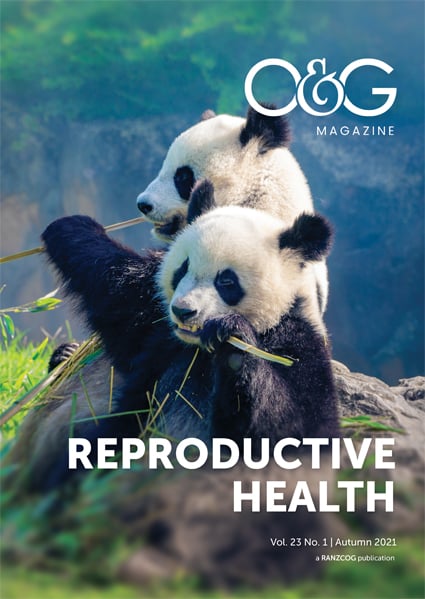Welcome to the Autumn issue of O&G Magazine. With maternal age being the best indicator of success for both spontaneous and assisted reproduction, it is fitting that a magazine dedicated to fertility and assisted reproduction is being published following Spring and Summer – a period of widespread new life, birth and growth. It is in the ‘Autumn’ of many patients’ reproductive lives that they will likely need assisted reproductive technologies; and with this analogy I look forward to revisiting Menopause in Winter!
As a FRANZCOG working in a private fertility clinic where the vast majority of my patients are well educated, intelligent people, I am always saddened by the lack of understanding and knowledge patients have regarding declining fertility rates and age. The upshot of a society where women are encouraged to break through the glass ceiling and climb the corporate ladder to achieve career success (that their mothers and grandmothers could only dream about) is a rapid increase in maternal age, a declining fertility rate and a booming IVF market.
On average, by the time a woman is 40 years of age, just over 20% of her eggs will be capable of making it to a blastocyst stage embryo and less than 40% of these embryos will be chromosomally normal.1 2 This gives each egg a less than 10% chance of producing a chromosomally normal embryo. A woman starting a single IVF cycle at 40 years of age has less than a 10% chance of a successful pregnancy.3 These rates are confronting to patients and there remains limited awareness within the general public regarding the significant decline in fertility rates with age.
The shock and disappointment when presented with these startling realities reflects the lack of general education to the public. The patients who are aware they should be seeking fertility assistance sooner rather than later due to their age are then often shocked that fertility treatment will not be the magic wand for which they’d hoped. The counter arguments that so many patients offer – the fact they exercise daily, take probiotics and eat organic – demonstrate the limited understanding many patients have about declining fertility rates and their cause. Unfortunately, no matter how well you have treated your body, the fact that your eggs have been around longer than you means that after the age of 35 a woman faces a very steep decline in fertility – whether she is trying for natural conception or undergoing fertility treatment.
A year ago, in response to my growing concerns at this lack of general understanding, I contacted my old high-school, a prestigious girls’ school in the leafy suburbs. I offered to speak with the students in the upper years as part of their health education program about fertility rates. I was hoping that, in conjunction with a talk about body image, contraception and sexually transmitted infections, I could impart some knowledge about declining fertility rates with age. My hope was that as these young women conquered the world, they would take the time to consider that if they wished to have a family, exploring this before their 35th birthday was probably a prudent idea. I did not hear back.
The increasing success and interest in oocyte cryopreservation over recent years has helped increase the public awareness of declining fertility rates with age. The concern with oocyte freezing though is that it is best performed before women reach their mid to late 30s, which is the time most patients actually present to explore their options. The chance of success with oocyte freezing is determined by the number of eggs that can be harvested and the quality of the eggs, both of which steadily decline with age. By the time a woman is in her late 30s, a single cycle of oocyte cryopreservation is unlikely to result in a successful pregnancy.
There is no Medicare rebate for ‘social egg freezing’ – a terrible term, but that is another article completely! At many thousands of dollars for each cycle, with the knowledge most women over 35 years old would be recommended to have more than two cycles to have a good chance of producing enough eggs to result in a single successful pregnancy, this process is financially out of reach for many women. When oocyte freezing is most likely at its sweet point – around 30 years old, a time when a woman’s egg reserve and egg quality is still high and she is most likely to be assessing her options as to what her reproductive plans are – the costs are extremely prohibitive. From a purely economic argument, the government subsidising oocyte cryopreservation could be seen as a wise decision. It would logically result in a significant reduction in the number of (largely unsuccessful) IVF cycles in women over the age of 40, cycles that are currently subsidised.
I would love to see government subsidised non-medically indicated oocyte cryopreservation be introduced to Australia and New Zealand. This would accompany a campaign to encourage people to not only consider their options if they are delaying trying for conception but also educate the public about declining fertility rates with age. This education program needs to start in high school. It is only with knowledge that we empower women to truly have control over their reproduction. Although I feel we have had great success with women in Australia and New Zealand having access to contraception and we are getting closer to gaining easy access to termination services for all women, I believe the new women’s movement needs to look at empowering women to have knowledge about their fertility chances as well as access to options that allow them the best chance of having the family they want, when they want.
References
- Pantos K, Athanasiou V, Stavrou D, et al. Influence of advanced age on the balstocyst development rate and pregnancy rate in assisted reproductive technology. Fertil Steril. 1999;71(6):1144-6.
- Franasiak JM, Forman EJ, Hong KH, et al. The nature of aneuploidy with increasing age of the female partner: a review of 15,169 consecutive trophectoderm biopsies evaluated with comprehensive chtromosomal screening. Assist Reprod. 2014;101(3):656-63.
- Newman JE, Fitzgerald O, Paul RC, Chambers GM. Assisted reproductive technology in Australia and New Zealand 2017. Sydney: National Perinatal Epidemiology and Statistics Unit, The University of New South Wales, Sydney. 2019.






Leave a Reply